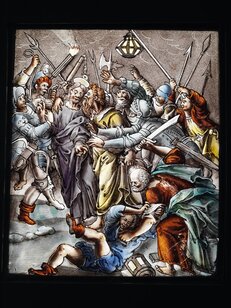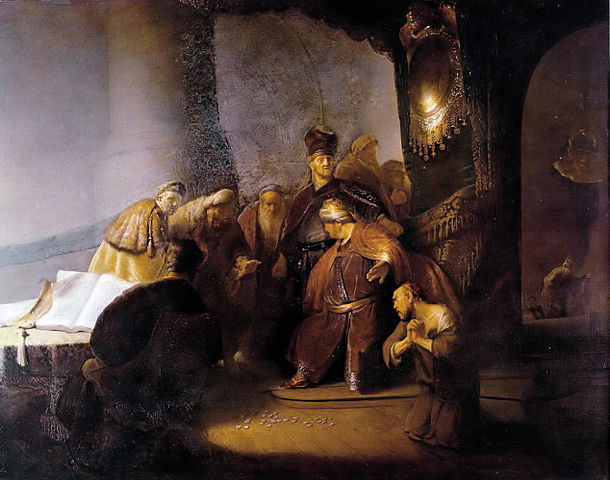|
This article comes from a review of an exhibition held at the Jewish Museum London in 2019. To read the full article, click here. Ironically, the exhibition includes scenes recorded in the New Testament, which is not part of the Jewish Bible. Nonetheless, certain events in the Gospels have played a major role in establishing the negative connection between Jews and money. “Then one of the Twelve—the one called Judas Iscariot—went to the chief priests and asked, “What are you willing to give me if I deliver him over to you?” So they counted out for him thirty pieces of silver. From then on Judas watched for an opportunity to hand him over.” – Matthew 26:14-16 (NIV) Judas Iscariot, the disciple who betrayed Jesus, has become the archetypal traitor and personification of the Jews. The Passion of Christ or the Easter story is well-known by the majority of the Western world regardless of religion. Judas’ involvement in the events leading up to Jesus’ crucifixion is perhaps not as recognised, however, his actions have permanently associated him with treachery and greed – something that managed to cast a shadow over the way Jews are perceived. In exchange for thirty silver coins, Judas Iscariot agreed to hand Jesus over to the Romans, thus allowing God’s plan to come to fruition. Despite being a small part in a much bigger story, Judas is often the man blamed for Jesus’ death. Depicted in artworks with red hair and wearing yellow, these colours have become icons of evil and deceit. The fact that the other Disciples were Jewish but had not betrayed Jesus is overshadowed by Judas’ treachery. A snap conclusion has been drawn that because Judas took the money and he was a Jew, then all Jews must be greedy. Whilst that statement can be seen as ridiculous, it managed to create an almost permanent judgment about Jews. In many artworks, Judas is portrayed with a money bag tied to his belt, suggesting his love of money, however, Rembrandt (1606-69) avoided this stereotypical imagery in his painting Judas Returning Thirty Pieces of Silver (1629). “Then Judas, which had betrayed him, when he saw that he was condemned, repented himself, and brought again the thirty pieces of silver to the chief priests and elders” – Matthew 27:3 Rembrandt’s painting shows the moment Judas attempts to return the money after he realises the extent of his actions. Judas kneels pleadingly on the floor, the thirty coins scattered at the feet of the priests and elders, who refuse to take the money back. Whilst his remorse is stronger than his desire to keep the money, some people point out that Rembrandt has painted Judas with his head turned towards the coins on the ground as though he still craves the money. Nevertheless, Judas, full of guilt and shame, hanged himself. “For I did dream of money bags tonight.” – Shylock, The Merchant of Venice The Jewish stereotype that stemmed from Judas was enhanced by William Shakespeare (1564-1616) in his play The Merchant of Venice. The play’s antagonist Shylock, is a Venetian Jewish moneylender who lends money to his Christian rival Antonio, setting the security at a pound of Antonio’s flesh. When Antonio cannot pay back the loan, Shylock demands his flesh. Throughout the play, Shylock’s appearance is stereotypical of the perception of Jews during the Elizabethan era. Jews had been expelled from England in 1290 and were not allowed to resettle in the country until Oliver Cromwell’s (1599-1658) rule, however, there were plenty of Jews in other countries, for instance, Venice, where the play is set. During the 16th and 17th century, Jews were often presented as a hideous caricature, usually with a hooked nose and bright red wig. Completing their costume, of course, was their ever-present money bag. Shylock’s forced conversion to Christianity at the end of the play is supposedly a happy ending, “saving” him from his unbelief and desire to kill Antonio. Overall, the play is typical of the antisemitic trends in Elizabethan England. ____________________________________ Jews, Money, Myth was an educational and eye-opening exhibition. Most people are aware of Jewish stereotypes and nearly everyone has learnt about the Holocaust, however, it is interesting to discover where and how these myths came about. Ultimately, the exhibition is challenging two particular tropes: “All Jews are rich,” and they “get rich at the expense of others.” Both statements are proved wrong and are only based upon a handful of Jews, for instance, the Rothschilds. This blog post was published with the permission of the author, Hazel Stainer. www.hazelstainer.wordpress.com
0 Comments
Your comment will be posted after it is approved.
Leave a Reply. |
©Copyright
We are happy for you to use any material found here, however, please acknowledge the source: www.gantshillurc.co.uk AuthorRev'd Martin Wheadon Archives
June 2024
Categories
All
|


 RSS Feed
RSS Feed